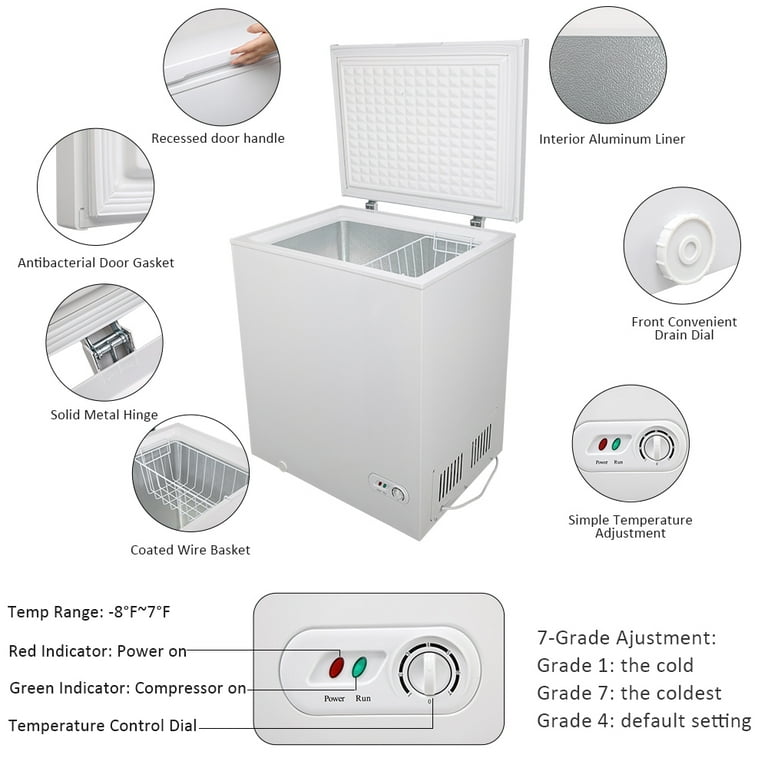Set your chest freezer temperature to -18°C (0°F) for optimal food preservation. This ensures food stays safe and maintains quality.
Maintaining the right temperature in your chest freezer is crucial for food safety and longevity. A temperature of -18°C (0°F) helps prevent bacterial growth and preserves the nutritional value of your stored items. This setting ensures that your food remains frozen solid, minimizing the risk of spoilage.
Regularly check your freezer’s temperature with a reliable thermometer to ensure it stays consistent. Avoid frequent opening of the freezer, as this can cause temperature fluctuations. Properly organizing your freezer can also aid in maintaining an even temperature throughout. By following these guidelines, you can keep your food fresh and safe for extended periods.

Credit: m.youtube.com
Ideal Temperature Range
Set chest freezer temperature between -10°F and 0°F to ensure food preservation and safety. This range prevents freezer burn while maintaining optimal freshness.
Recommended Settings
The best setting for a chest freezer is 0°F or -18°C. This keeps food fresh and safe to eat. Always check the temperature with a thermometer. Make sure the freezer is always at this level.
Factors Affecting Temperature
Many things can change the freezer’s temperature. Room temperature can make the freezer work harder. Opening the door often lets warm air in. Overloading the freezer can block air flow. Keep these factors in mind for best results.
Benefits Of Proper Settings
Proper temperature settings keep food fresh. Cold temperatures slow down bacteria growth. This helps food stay safe to eat. Fresh food tastes better and has more nutrients. Store food at the right temperature to avoid spoilage.
Energy-efficient settings save money on electricity. A good setting reduces the strain on the freezer. This makes the freezer last longer. Energy-efficient freezers are better for the environment. Proper settings help you save on energy bills.
Adjusting Temperature
Turn the dial to change the temperature. Lower numbers mean warmer settings. Higher numbers make the freezer colder. Check the manual for recommended settings. Use a thermometer to verify the temperature. Adjust as needed for best results.
Press the buttons to set the temperature. Digital controls are precise. Look at the display for the current setting. Set it to the desired temperature. Check the freezer regularly to ensure it stays cold. Adjust if the temperature fluctuates.
Seasonal Considerations
During winter, chest freezers often work more efficiently. The ambient temperature is lower, which helps maintain the freezer’s cold interior. Set the freezer to a slightly higher temperature to save energy. This also prevents food from freezing too hard. A good setting is around 0°F (-18°C). Check the freezer regularly to ensure it maintains the correct temperature.
Summer heat makes freezers work harder. Set the temperature to -10°F (-23°C) to compensate. Ensure there is enough space around the freezer for air circulation. This helps the freezer run efficiently. Regularly check the seals on the door. Proper seals keep warm air out. Clean the freezer coils to improve performance.
Storing Different Foods
Meat and poultry should be kept at a temperature of 0°F. This keeps the food safe and prevents bacteria growth. It’s important to store these items in sealed bags. This helps to avoid freezer burn. Always label the bags with the date. This helps to keep track of how long they have been stored. Use the oldest items first to maintain freshness.
Fruits and vegetables require a temperature of 0°F as well. They should be stored in airtight containers. This keeps them fresh and prevents ice crystals. Blanching vegetables before freezing can help maintain their quality. Label all containers with the date. This will help you use the oldest items first. Enjoy fresh produce even in the off-season.

Credit: www.walmart.com
Maintenance Tips
Use a damp cloth to wipe the inside. Clean the shelves and drawers. Remove old food and spills. This keeps your freezer smelling fresh. It also helps in keeping the temperature stable. Always unplug the freezer before cleaning.
Check for frost build-up every month. Too much frost can block the airflow. Use a plastic scraper to remove frost. Never use sharp objects. Keep the freezer door closed as much as possible. This reduces frost build-up.
Troubleshooting Issues
The chest freezer may have inconsistent temperature due to several reasons. Check if the door seal is tight. A loose seal can cause temperature fluctuations. Ensure the freezer is not overloaded. Too many items can block air circulation. Regularly clean the condenser coils. Dusty coils affect cooling efficiency. Make sure the thermostat is set correctly. An incorrect setting can lead to inconsistent temperatures.
If the freezer is not cooling, check the power supply first. Ensure the freezer is properly plugged in. Inspect the circuit breaker for any tripped switches. Verify that the temperature setting is correct. Sometimes, it might be set too high. Clean the condenser coils as dust can cause cooling issues. Ensure adequate ventilation around the freezer. Blocked vents can affect cooling. If none of these work, the compressor might need professional attention.
Energy-saving Tips
Place the chest freezer in a cool, dry area. Avoid direct sunlight and heat sources. Leave some space around the freezer for air circulation. This helps the freezer work efficiently. The freezer should not be near ovens or dishwashers. A stable temperature helps save energy.
Check the door seal regularly. Make sure it is clean and not damaged. A damaged seal lets warm air in and cold air out. This makes the freezer work harder. Cleaning the seal with mild soap and water helps maintain its condition. Replace the seal if it is cracked or torn.

Credit: www.reddit.com
Frequently Asked Questions
Is 1 Or 7 Colder On A Chest Freezer?
Setting 7 is colder on a chest freezer. Lower numbers indicate warmer temperatures, while higher numbers indicate colder temperatures.
Should My Freezer Be On 1 Or 5?
Set your freezer between 3 and 4 for optimal performance. Settings vary by model, so check your manual.
What Is The Best Temperature For A Meat Freezer?
The best temperature for a meat freezer is 0°F (-18°C). This ensures meat stays safe and maintains quality.
What Temperature Should A Freezer Be Set At In Degrees?
A freezer should be set at 0 degrees Fahrenheit (-18 degrees Celsius) for optimal food preservation. This temperature ensures food stays safe and maintains quality. Regularly check and adjust your freezer settings to maintain this ideal temperature.
Conclusion
Setting the right temperature for your chest freezer is crucial. It ensures food stays fresh and safe. Always follow manufacturer guidelines and regularly check the temperature. Proper settings can save energy and extend the freezer’s life. Keep your freezer efficient and your food at its best with the right temperature setting.
